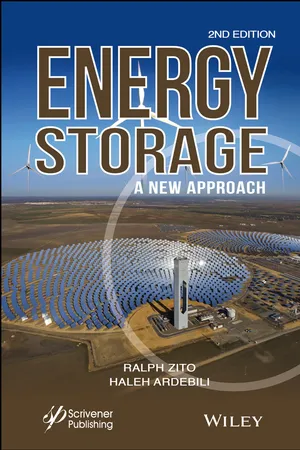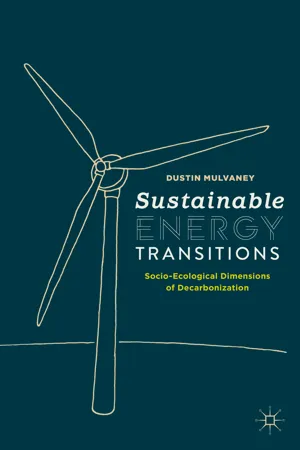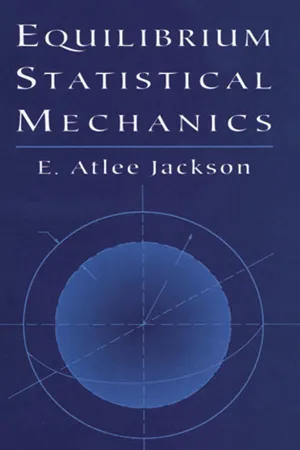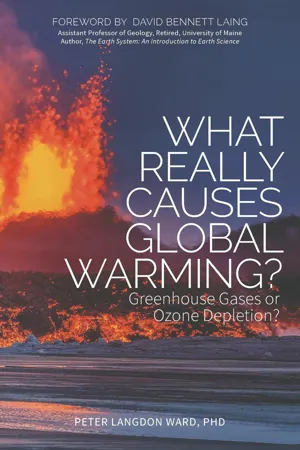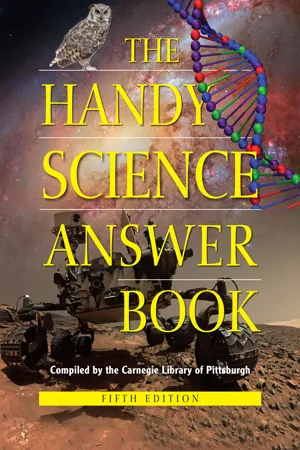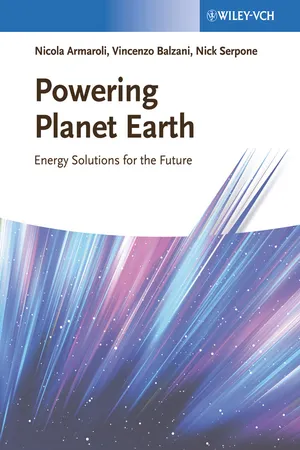Physics
Energy Physics
Energy physics is the branch of physics that focuses on the study of energy and its various forms, including potential energy, kinetic energy, and thermal energy. It explores the principles governing the transformation of energy from one form to another and its impact on the behavior of physical systems. Understanding energy physics is crucial for comprehending the fundamental processes underlying natural phenomena and technological advancements.
Written by Perlego with AI-assistance
Related key terms
Related key terms
1 of 4
Related key terms
1 of 3
8 Key excerpts on "Energy Physics"
- eBook - ePub
Energy Storage
A New Approach
- Ralph Zito, Haleh Ardebili(Authors)
- 2019(Publication Date)
- Wiley-Scrivener(Publisher)
The history of the development of physical concepts is not the prime concern here, but some knowledge of their evolution does serve to bring more closely to our attention and scrutiny a better appreciation of terms that we employ daily. Sometimes it is necessary to begin understanding or developing a body of knowledge in order to make certain basic assumptions on an entirely intuitive basis. As scientifically unsatisfying as that may be, it is unavoidable at times. One could draw a weak comparison to plane geometry (Euclid) with regard to its various axioms and the declaration that parallel lines never meet. Even the concept of straight lines is rather intuitive in nature.Perhaps the best definition is that a force is required to change the motion of a body. Many problems arise in finding acceptable definitions for the basic parameters of physical science, namely, the abstract concepts of mass, time, force, and energy. However, we must learn to be satisfied with definitions that leave something to be desired in order to move on toward generating a working body of mechanics that enables us to design and build practical devices that serve our purposes.An interesting definition of energy comes from the Grolier Encyclopedia, which states:Energy can be measured in terms of mechanical work, but because not all forms of energy can be converted into useful work, it is more precise to say that the energy of a system changes by an amount equal to the net work done on the system … In classical physics, energy, like work, is considered a scalar quantity; the units of energy are the same as those of work. These units may be ergs, joules, watt-hours, foot-pounds, or foot-poundals, depending on the system of units being used. In modern science, energy and the three components of linear momentum are thought of as different aspects of a single four-dimensional vector quantity, much as time is considered to be one aspect of the four-dimensional space-time continuum … Energy exists in many different forms. The form that bodies in motion possess is called kinetic energy. Energy may be stored in the form of potential energy, as it is in a compressed spring. Chemical systems possess internal energy, which can be converted by various devices into useful work; for example, a fuel such as gasoline can be burned in an engine to propel a vehicle. Heat energy may be absorbed or released when the internal energy of a system changes while work is done on or by the system. (1993) - eBook - ePub
- Justin P. Lomont, Ian C. Stewart(Authors)
- 2013(Publication Date)
- Visible Ink Press(Publisher)
PHYSICAL AND THEORETICAL CHEMISTRY
ENERGY IS EVERYTHING
What is physical chemistry?Physical chemistry is a branch of chemistry primarily concerned with developing a better understanding of the fundamental principles that govern chemical processes. It is an empirical science, meaning that it is based on experimental observations, though it is probably the most closely linked experimental branch of chemistry to developing new theories in chemistry. As the name implies, physical chemistry is intrinsically concerned with topics in physics that are also relevant to the study of chemistry.What is energy?In chemistry, energy serves as the “currency” for making or breaking chemical bonds and moving molecules (or matter) from one place to another.What is potential energy?Potential energy describes all of the nonkinetic energy associated with an object. This energy can be the energy stored in chemical bonds, in a compressed spring, or in a variety of other ways. Another example is gravitational potential energy, like that associated with a ball sitting at the top of a hill. Since there are many types of potential energy, there isn’t a single equation that describes them all. Since the value we assign to potential energy is always inherently described relative to some choice of a reference value, we can only actually measure changes in potential energy in a meaningful way. A closed system can exchange potential energy for kinetic and vice versa, but the total energy must always remain constant. This is stated in the First Law of Thermodynamics, which we’ll get to soon.What is kinetic energy?Kinetic energy is the type of energy associated with the movement of an object. Faster-moving objects have more kinetic energy, and the kinetic energy of an object is related to its mass, m, and velocity, v, by the equation: - eBook - ePub
- A. L. Stanford, J. M. Tanner(Authors)
- 2014(Publication Date)
- Academic Press(Publisher)
5Work, Power, and Energy
Publisher Summary
This chapter discusses physical quantities and concepts necessary for the understanding of energy and its associated conservation principle. In the nonscientific world, work is often thought of in terms of some physical or mental effort. In physics, however, the term work is defined precisely. Doing work requires the use of force, and work on a body does not take place without displacement of that body. The rate at which work is done is often of interest in practical applications. Power is the measure of the rate at which work is being done. It is sometimes convenient to express power in terms of a constant force acting on an object moving at a constant velocity. A unit commonly used for measuring electrical power is the kilowatt . A particle or a system of particles that has the capacity to do work is said to possess energy, a physical quantity associated with the particle or system that may take many forms. In the technical sense, however, a system that has the ability to do work is said to have energy. Energy is a scalar quantity that is usually expressed in terms of the same units as those of work.This chapter introduces one of the most important and perhaps the most far-reaching of all principles in the sciences—the conservation of energy. A conservation principle is a rule or a natural law that specifies that the value of a physical quantity does not change during the course of a physical process but remains constant. The quantity that does not change is said to be conserved. The simplicity of conservation principles makes them concise expressions of natural law and powerful tools of scientific analysis. Conservation of energy is only one of a number of conservation principles that students of science or engineering will encounter. The significance and the usefulness of these principles should become apparent to the student as they are used to analyze and interpret physical phenomena. - eBook - ePub
Sustainable Energy Transitions
Socio-Ecological Dimensions of Decarbonization
- Dustin Mulvaney(Author)
- 2020(Publication Date)
- Palgrave Macmillan(Publisher)
Throughout this chapter, there are example problems that review energy-to-power relations, unit conversions, and stoichiometry, in addition to a handful of empirical problem sets and assignment. The chapter ends with a discussion about how concepts like entropy can provide a scientific basis for understanding how natural resource use has implications for intergenerational equality—the idea that resources must be managed for future generations (Costanza et al. 2014). 2.1 Power and Energy Energy is fundamental stuff. It is what allows life to occur, through metabolism and eventually decay. It shapes where non-living things are and where they are going. As the property of a star, the amount of energy determines whether humans could eventually inhabit those places. Energy also enables humans to develop the societies that exist today, and the linkages between peoples, economies, and nature in different parts of the world. Vaclav Smil describes energy use by human civilization as its metabolism—borrowing a metaphor for how living organisms process energy to fuel their needs and wants. What is energy? From your biology, physics, or chemistry classes in school you may recall that energy is the ability to do work or the ability to transform a system. Energy is encountered in different forms, but most often its presence is suggested by motion, activity, light, heat, or change. As a fundamental law of the universe, energy is always conserved. The energy that was present at the start of the universe is all still in the universe. This means energy cannot be created, only converted and transformed. Energy is a discrete quantity. This makes it different than power, which is a flow rate quantity of energy. Energy is the amount of power over time measured in joules (J) - eBook - ePub
- E. Atlee Jackson(Author)
- 2012(Publication Date)
- Dover Publications(Publisher)
models (simplified pictures) of atoms, molecules, gases, and solids will illustrate the various types of interactions between particles. Finally, we shall consider some of the important modifications of these classical models that are required by quantum mechanics.2. KINETIC AND POTENTIAL ENERGY
To begin with, let us consider a particle moving in space as it is described in classical mechanics. The position of the particle r (t ) = x (t )i + y (t )j + z (t )k [where (i, j, k ) are the unit vectors in the (x , y , z ) directions] generally varies in time and has a velocityIf the particle has a mass m, it is said to have a kinetic energy (sometimes called the translational energy )(1)If a force F acts on the particle, its velocity will change according to Newton’s law(2)If no force acts on the particle, then it follows from Equation (2) that v is independent of the time, and consequently the kinetic energy is also a constant. We can also see this from the fact that(3)which vanishes if F vanishes.Now the force that acts on the particle generally depends on the position of the particle r and sometimes also on the velocity (e.g., frictional forces, or the force on a charged particle moving in a magnetic field). If the force depends only on r and if it can be expressed in terms of the gradient of some function Φ - eBook - ePub
What Really Causes Global Warming?
Greenhouse Gases or Ozone Depletion?
- Peter Langdon Ward(Author)
- 2015(Publication Date)
- Morgan James Publishing(Publisher)
Understanding quantum electrodynamics is closely related to understanding how solar radiation interacts with Earth’s atmosphere and Earth’s surface. Feynman’s statement that energy does not come “in little blobs of a definite amount” contradicts what is assumed by all climate models and by all climatologists when they calculate radiative forcing. Radiative forcings are additive, they each lead to little blobs of energy of a definite amount. Jennifer Coopersmith, in her book Energy, the Subtle Concept, 84 concludes that energy is “what makes things happen.” Energy is “the ‘go’ of the Universe.” Energy causes things to happen around us. No change is possible without utilizing some energy. Thus, far from being a thing “in little blobs of a definite amount,” energy is actually a description of the condition or state of a thing—the ‘go’ of a thing. Physicists like to define energy as the ability to do work and to define work as force times displacement, but this definition does not apply to thermal or chemical energy. You get energy from digesting food, and this allows you to do work. Plants absorb energy from Sun, allowing them to grow. Dead plants contain energy that we can access by lighting them on fire. Fossil plants contain energy that we can utilize when we burn coal. The amount of energy that something has refers to its capacity to cause change. Higher (greater) energy typically makes more things happen in a shorter period of time. A fundamental property of energy is that it is conserved, as was first stated by William Rankine in 1850 in the law of the conservation of energy. 85 Energy cannot be created or destroyed. It can only be converted from one form to another. This is known as the first law of thermodynamics—the study of thermal energy in motion. This law has been interpreted as meaning that the total amount of energy in the Universe is fixed, although it is strictly applicable only to thermodynamically isolated systems - eBook - ePub
- James Bobick, Naomi E. Balaban(Authors)
- 2019(Publication Date)
- Visible Ink Press(Publisher)
Physicists define energy as the capacity to do work. Work is defined as the force required to move an object some distance. Examples of the different kinds of energy are thermal (heat) energy, light (radiant) energy, mechanical energy, electrical energy, and nuclear energy. The law of the conservation of energy states that within an isolated system, energy may be transformed from one form to another, but it cannot be created nor can it be destroyed.What are the two forms of energy?The two forms of energy are kinetic (working) energy and potential (stored) energy. Kinetic energy is the energy possessed by an object as a result of its motion, while potential energy is the energy possessed (stored) by an object as a result of its position. As an example, a ball sitting on top of a fence has potential energy. When the ball falls off the fence, it has kinetic energy. The potential energy is transformed into kinetic energy. Some examples of different forms of energy are:•Chemical energy is a form of potential energy. It is the energy stored in the bonds of atoms and molecules. Some examples of chemical energy are batteries, biomass, petroleum, natural gas, and coal. •Mechanical energy is also a form of potential energy. It is stored in objects by tension. Examples of mechanical energy are compressed springs and stretched rubber bands. •Nuclear energy is energy stored in the nucleus of an atom. Large amounts of energy may be released when the nuclei are combined or split apart. Nuclear energy is a form of potential energy.•Gravitational energy is energy stored in an object’s height. The higher and heavier the object, the more gravitational energy is stored. As an object goes down a hill and picks up speed, the gravitational energy is converted to motion energy. Gravitational energy is also a form of potential energy.•Radiant energy is electromagnetic energy that travels in transverse waves. Light and sunshine are examples of radiant energy. It is a form of kinetic energy. - eBook - ePub
Powering Planet Earth
Energy Solutions for the Future
- Nicola Armaroli, Vincenzo Balzani, Nick Serpone(Authors)
- 2012(Publication Date)
- Wiley-VCH(Publisher)
“the power, virtue, and efficacy of a thing.”If we’ve come to understand the notions of what energy is and what laws and principles govern it, it is mostly thanks to the passionate and prolific insights of a small group of curious men that, since the end of the eighteenth century, dedicated much of their time to this problem: men such as James Watt, Sadie Carnot, Justus von Liebig, James Joule, Rudolf Clausius, William Thompson (better known as Lord Kelvin), Ludwig Boltzmann, Walther Nernst, and Albert Einstein.Energy and Related Terms
The concept of energy is not immediately definable. Before we attempt to understand what energy is, we need to define another concept that precedes it: work .Work can be described as the use of a force to move something. The amount of work depends on how much force is used and the distance the object is moved to. From a mathematical point of view, work is the product of force × distance .We do work when we lift a weight against the force of gravity, such as, for example, lifting a crate of apples. The magnitude of the work needed depends on the mass being moved (how many apples are there in the crate?), the magnitude of the gravitational force (whether we’re on Earth or on the Moon) and the height to which we want to lift the object to: on the table? – on the shelf above?Often the mass may be that of our bodies: for example, we do work when we climb the stairs or a ladder. Since the force of gravity is identical in the Italian regions of Valle d’Aosta and Abruzzo, and the mass to be moved is constant over the years (provided we maintained our figure), greater work will be needed to climb to the top of Mont Blanc, 4810 meters, than to climb to the top of the Gran Sasso at 2912 meters in the Apennine mountain chain of Italy.
Index pages curate the most relevant extracts from our library of academic textbooks. They’ve been created using an in-house natural language model (NLM), each adding context and meaning to key research topics.
Explore more topic indexes
Explore more topic indexes
1 of 6
Explore more topic indexes
1 of 4
